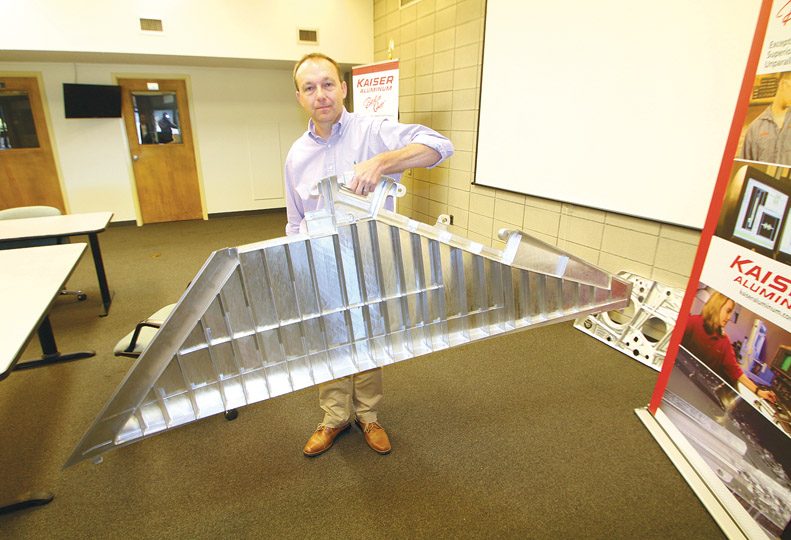
Home » Kaiser plans to increase efficiency with upgrades at Trentwood
Kaiser plans to increase efficiency with upgrades at Trentwood
$150 million dedicated to modernization

April 21, 2016
Kaiser Aluminum Corp. vice president Scott Endres says the $150 million investment the company has committed to its Trentwood plant in Spokane Valley in the next five years is vital to keeping the company competitive in the global market for its immediate and long-term future.
Company CEO and chairman Jack A. Hockema says the multiyear expenditure at Trentwood is focused on major equipment upgrades throughout the process flow, designed to reduce conversion costs and increase efficiency.
“In addition to cost and quality benefits, the investments will also result in an additional 5 percent to 10 percent increase in Trentwood’s manufacturing capacity by early 2018,” Hockema says in the company’s 2015 annual report released in February.
The dedication of resources to that facility, and others around the country, have company officials expecting a strong 2016.
Hockema says Kaiser, based in Foothill Ranch, Calif., is expecting to see a 3 percent to 5 percent increase in revenue, driven mostly by the aerospace and automotive industries. The company will announce its 2016 first quarter earnings on April 21.
With 11 manufacturing facilities in the U.S. and one in Canada, Kaiser says it posted record revenue of $790 million in 2015. That’s an increase of about $57 million, or 8 percent, compared with $733 million in 2014, Hockema says.
“Value-added revenue for the full year 2015 reflected our seventh consecutive year of record heat treat plate shipments, and our fifth consecutive year for record automotive value-added revenue,” Hockema says in the year-end report.
“For the full year 2015 we achieved record results for shipments, value added revenue and adjusted EBITDA (earnings before interest, taxes, depreciation and amortization),” Hockema says.
Endres says the continued emergence of low-cost aluminum production in the last decade in countries such as China and Mexico present stiffer global competition.
“It’s a very competitive marketplace. You’re either at the table or on the menu,” Endres says.
That’s why Kaiser puts strong emphasis on manufacturing high-quality aluminum, the majority of which is sold to companies in the aerospace and commercial flight sector for aircraft. Boeing Co. and French-based Airbus are two of Kaiser Aluminum’s largest global buyers, Endres says.
“When you build an aircraft, you better get it right,” he says.
Kaiser manufactures plate, sheet, and coil products specially tailored for the aerospace and high-strength markets. The company recently introduced KaiserSelect Aerospace Plate product AA7099, which is now specified for a structural application for twin-aisle aircraft, says the company’s website.
Auto manufacturers, including Honda, are also large purchasers of Kaiser’s aluminum products, Endres says.
Kaiser says its Trentwood facility is the largest flat-rolled aluminum mill in the western U.S. Kaiser Trentwood has more than 900 employees.
Industrialist Henry Kaiser purchased the plant from the government in 1946 after the end of World War II. Kaiser owns 515 acres while the physical plant—located at 15000 E. Euclid—encompasses 60 acres. It took more than 2,400 people to build the plant in 1942, Endres says.
For decades, Kaiser was near the center of the U.S. manufacturing industry. Endres says the company still plays a vital manufacturing role but adds, “We’re (the U.S.) bleeding manufacturing jobs.”
Endres says Kaiser must continue to adapt and evolve if it is to be around for future generations.
To accomplish that, the company has taken proactive roles in a variety of areas as it does business.
Company executives meet regularly with representatives from the Washington governor’s office, the state’s Department of Ecology and environmental organizations to discuss ways to continue to improve recycling efforts and reducing carbon emissions generated at the plant, Endres says.
“Melting aluminum is a very intensive process and it can’t be accomplished using solar or wind energy,” he says.
It takes temperatures of 1,700 to 2,000 degrees Fahrenheit to melt aluminum, he adds.
Trentwood is a valuable facility for Kaiser Aluminum for many reasons, Endres says, and a distinct advantage to being in the Pacific Northwest is that hydroelectric power generated from dams helps play a role in reducing the cost of melting aluminum.
Kaiser also has evolved in the way it interacts with its workers, specifically the way it negotiates contracts, a direct result of the two-year labor dispute that occurred in the mid ’90s that led to a bankruptcy filing and the shuttering of a former smelter plant located in Mead.
“Now we negotiate our contracts early, starting a year out,” says Kyle England, Kaiser’s human resources manager here.
England says Kaiser reached a labor agreement with workers in 2015 after starting discussions with the United Steelworkers Union the year before. Kaiser Aluminum doesn’t discuss details of employee contracts.
Endres and England say employing lean management principles, continually improving efficiency and quality, have created sustained employment growth at the Trentwood plant.
“We haven’t advertised much, but when we post for production positions, we’ll get anywhere from 400 to 600 applications,” says the 46-year-old England who has been working at Kaiser since he was 19. “Kaiser is still highly regarded and recognized as a destination place to work.”
Says Endres, “There’s a lot of great work out here being done by more than 900 employees. It’s those jobs that built this community and this country.”
Latest News Manufacturing
Related Articles




_web.jpg?1729753270)